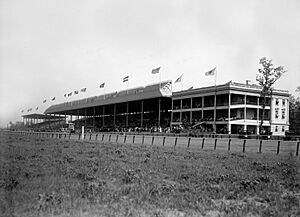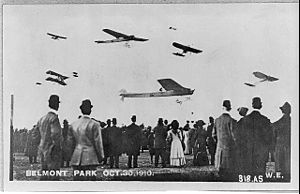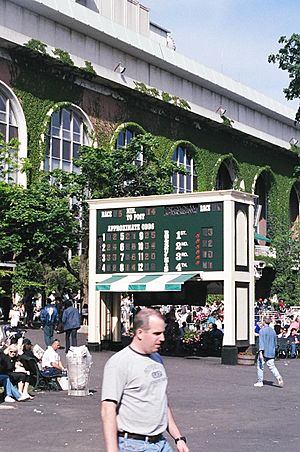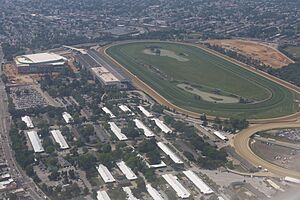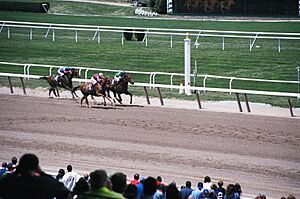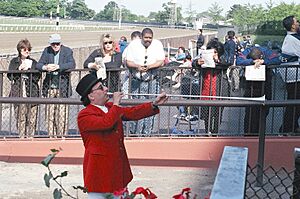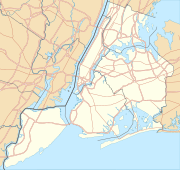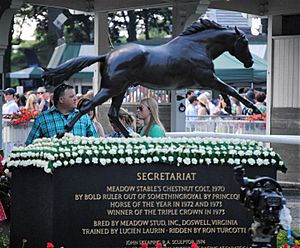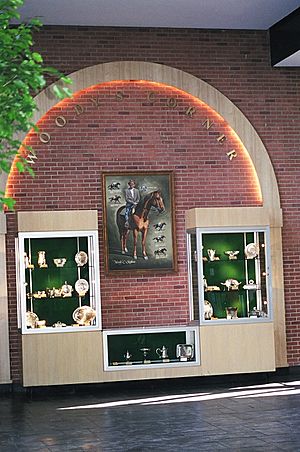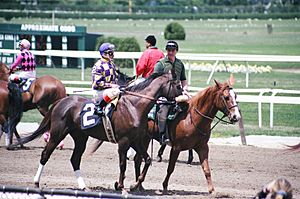Belmont Park facts for kids
 |
|
| Location | 2150 Hempstead Turnpike Elmont, New York, U.S. |
|---|---|
| Coordinates | 40°42′54″N 73°43′22″W / 40.71500°N 73.72278°W |
| Owned by | State of New York |
| Operated by | New York Racing Association |
| Date opened | May 4, 1905 May 20, 1968 (renovation) |
| Capacity | 100,000 |
| Screened on |
|
| Course type | Flat/Thoroughbred 1.5 miles (2.4 km) |
| Notable races |
|
Belmont Park is a famous horse racetrack located in Elmont, New York. It's just east of New York City. This track is best known for hosting the Belmont Stakes. This race is the final part of the American Triple Crown.
Belmont Park first opened on May 4, 1905. It quickly became one of the most famous racetracks in the United States. The original building was taken down in 1963. A new one opened in 1968. That second building was also taken down in 2023. A third version of Belmont Park is expected to open in 2026.
The New York Racing Association (NYRA) runs Belmont Park. Races usually happen from late April to mid-July. This is called the Spring meet. Then, races happen again from mid-September to late October, known as the Fall meet. The main dirt track at Belmont is nicknamed "the Big Sandy." This is because it's very large and has a deep surface.
Belmont is also called "The Championship Track." Many major champion horses have raced here since the early 1900s. This includes all the Triple Crown winners. Belmont Park is known for its wide turns and long finish line. This makes it one of the fairest racetracks in America.
The biggest crowd at Belmont was in 2004. Over 120,000 people watched the 2004 Belmont Stakes. They saw Smarty Jones lose to Birdstone in his try for the Triple Crown.
Contents
History of Belmont Park
The First Belmont Park (1903–1963)
August Belmont Jr. and William Collins Whitney helped build the first Belmont race track. It opened on May 4, 1905. Arthur Underhill designed the park. For about 15 years, races at Belmont Park ran clockwise. This was like racing in England. It allowed people in the clubhouse to see the races finish right in front of them.
Later, Joseph E. Widener became the track leader in 1924. He added the Widener Chute. This was a straight path that cut through the tracks. It was removed in 1958.

Two parts of the original Belmont Park are still there today. First, there are four stone pillars on Hempstead Turnpike. These were a gift from Charleston, South Carolina. They used to be at the entrance of another race track. Now, they are at the clubhouse entrance. Also, some iron railings with racing designs are still visible. They were saved when the old grandstand was taken down in 1963.
The first Belmont Park was very large. It also had a new feature: a Long Island Rail Road extension. This train line went under Hempstead Turnpike. It ended right at the track. The train station moved to its current spot in 1956.
The last race at the old Belmont Park was in October 1962. In 1963, officials said the grandstand was unsafe. It was too old and needed to be rebuilt. So, the old building was taken down.
Aviation Events at Belmont
Belmont Park also played a part in aviation history. On October 30, 1910, about 150,000 people came to the track. They watched an International Aviation Meet at Belmont Park. This event was put on by the Wright Brothers. It happened when horse racing was not allowed in New York State.
Eight years later, Belmont was used for aviation again. It was the northern starting point for the first U.S. air mail route. This route went between New York and Washington, D.C.
The Second Belmont Park (1968–2024)
While the second grandstand was being built, Belmont races moved to Aqueduct Racetrack. This was from 1963 to 1968. The new grandstand cost $30.7 million. It opened on May 20, 1968. It was the largest in Thoroughbred racing. It could hold over 100,000 people. This included seats for 33,000.
A long painting by Pierre Bellocq is on the second floor of the clubhouse. It shows famous jockeys, trainers, and racing people. It celebrates the track's history.
In 2022, the New York Racing Association decided to update Belmont. They wanted it to host racing and training all year. An underground tunnel was built to connect to the parking lot.
In April 2023, work began on a new one-mile synthetic racing track. This track is inside the inner turf course. The next part of the rebuilding started after the 2023 spring and summer races. It included finishing the synthetic track. It also made the inner turf course wider. A second infield tunnel was also built. On May 1, 2023, NYRA announced that $455 million was secured for the grandstand and other projects.
The last day of racing at the second Belmont Park was July 9, 2023. The demolition of the second grandstand started in March 2024 and finished in June 2024.
UBS Arena
In July 2017, New York State looked for plans for empty parking lots at Belmont. Two professional sports teams were interested. The New York Islanders (an NHL hockey team) and New York City FC (an MLS soccer team). Both teams wanted new stadiums.
The Islanders suggested building an 18,000-seat sports arena. They also planned for shops, a hotel, and a community center. New York City FC wanted a 26,000-seat soccer stadium. Both plans included better parking and train access.
On December 20, 2017, New York Governor Andrew Cuomo announced the Islanders' project was approved. The UBS Arena opened for the 2021-22 NHL season. The plan also included a new Elmont station for the Long Island Rail Road.
The Third Belmont Park (Under Construction; Opening 2026)
As of July 2024, the second Belmont Park is completely gone. Rebuilding is planned until September 2026. The new grandstand will likely allow the track to host the Breeders' Cup again. This would be the first time since 2005.
Because of the construction, the Belmont fall races moved to Aqueduct in 2022, 2023, and 2024. The 2024 Belmont Stakes and 2025 Belmont Stakes were moved to Saratoga Race Course. The 2026 Belmont Stakes is also planned for Saratoga.
In February 2025, the foundation for the new grandstand was poured. The new dirt, turf, and synthetic tracks were outlined. The turf tracks will be shorter. The finish line will move forward by 125 feet.
The new Belmont Park is set to open in September 2026. This will likely lead to the closing of nearby Aqueduct Racetrack.
Track Features
The Belmont Park complex covers about 430 acres (170 ha). It includes racing, training, and horse barns. It's located in Elmont, New York. Just a few miles east, the first horse race in North America happened in 1665.
The main dirt track is called "Big Sandy." It is 1+1⁄2 miles (2.4 km) around. This makes it the longest dirt track for thoroughbreds in North America. Inside this track is the Widener Turf Course. It is named after the Widener family, who are famous in horse racing. This turf course is 1+5⁄16 miles (2.1 km) long. Inside that is an Inner Turf Course, which is 1+3⁄16 miles (1.9 km) around.
On the main track, the distance from the start of the final stretch to the finish line is 1,097 feet (334 m). Lights were added to the training track in 2009. This was to make early morning workouts safer.
Location of Belmont Park
The racetrack, grandstand, and training areas are all in Elmont, New York. This is in Nassau County, New York. However, the Long Island Rail Road station and some parking areas are right on the border with Queens County.
Belmont Park has direct exits from the Cross Island Parkway. This road runs north and south, just west of the park. The address for Belmont Park is 2150 Hempstead Turnpike.
Horse Racing at Belmont
The Belmont Stakes Race
The Belmont Stakes race is named after August Belmont Sr.. He was a financier and sportsman who helped pay for the race. Most people believe the racetrack itself was also named after him.
The first Belmont Stakes race was in 1867. It was held at Jerome Park Racetrack in the Bronx. In 1937, special iron gates from that first race were given to Belmont Park. They were on the fourth floor of the clubhouse until it was taken down in 2024.
The Belmont Stakes has been run at Belmont Park since 1905. There were a few exceptions. In 1911–12, gambling was banned in New York. From 1963–67, the race was at Aqueduct while Belmont was rebuilt. In 2024 and 2025, the race moved to Saratoga Race Course due to the second rebuilding of Belmont Park.
Secretariat won the 1973 Belmont Stakes in 2 minutes, 24 seconds. This set a world record for 1+1⁄2 miles (2.4 km) on dirt. That record still stands today. His 31-length victory secured the first Triple Crown in 25 years. A statue of Secretariat is in the middle of the Belmont paddock.
Another special achievement is honored by the "Woody's Corner" display. It was in the clubhouse lobby. It celebrated Woody Stephens, who trained five Belmont Stakes winners in a row from 1982 to 1986.
Belmont Park was also the site of Affirmed's close win over Alydar in the 1978 Belmont Stakes. This victory gave Affirmed the Triple Crown. Later that year, Triple Crown winner Seattle Slew beat Affirmed in the Marlboro Cup.
Officials worked to get more people to come to Belmont Stakes Day. In 2004, a record 120,139 people came. They wanted to see if Smarty Jones would win the Triple Crown.
American Pharoah won the 2015 Belmont Stakes on June 6. He became the first Triple Crown winner in 37 years. The attendance for that race was limited to 90,000 people.
Other Important Races at Belmont
Besides the Belmont Stakes, many other big races are held at Belmont. These include the Jockey Club Gold Cup, the Suburban Handicap, and the Metropolitan Handicap. The Metropolitan Handicap is also known as the "Met Mile."
The Acorn Stakes is an important race for young female horses. It is the first part of the US Triple Tiara. This race is also held at Belmont.
All these races are on dirt. Important races on the grass (turf) include the Belmont Derby, Belmont Oaks, Manhattan Handicap, and Man O' War Stakes.
Belmont's Fall Championship meet has New York Showcase Day in late October. This day features seven races for horses born in New York. The richest race is the $250,000 Empire Classic Handicap.
In 1923, Belmont Park hosted a special race. It was between American champion Zev and English champion Papyrus. Zev won by five lengths in front of about 70,000 people.
Belmont Park was also the site of a sad race in 1975. It was a match race between Foolish Pleasure and the champion female horse Ruffian. Ruffian was badly injured during the race and had to be put down. She was buried near the finish line at Belmont Park.
Graded Races
The following Graded events were held at Belmont at the Big A in 2025.
Grade I
- Acorn Stakes
- Belmont Derby
- Belmont Oaks
- Belmont Stakes
- Champagne Stakes
- Frizette Stakes
- Jaipur Invitational Stakes
- Joe Hirsch Turf Classic
- Just a Game Stakes
- Manhattan Stakes
- Ogden Phipps Stakes
- Metropolitan Handicap
- New York Stakes
- Woody Stephens Stakes
Grade II
- Bed O' Roses Invitational Stakes
- Beldame Stakes
- Belmont Gold Cup Invitational Stakes
- Brooklyn Invitational Stakes
- Gallant Bloom Handicap
- Hill Prince Stakes
- Kelso Handicap
- Knickerbocker Stakes
- Man o' War Stakes
- Miss Grillo Stakes
- Mother Goose Stakes
- Ruffian Handicap
- Sands Point Stakes
- Sheepshead Bay Stakes
- Suburban Stakes
- True North Stakes
- Wonder Again Stakes
- Woodward Stakes
Grade III
- Athenia Stakes
- Beaugay Stakes
- Bold Ruler Handicap
- Dwyer Stakes
- Fort Marcy Stakes
- Futurity Stakes
- Intercontinental Stakes
- Jockey Club Derby
- Jockey Club Oaks
- John A. Nerud Stakes
- Matron Stakes
- Noble Damsel Handicap
- Pennine Ridge Stakes
- Pebbles Stakes
- Peter Pan Stakes
- Pilgrim Stakes
- Poker Stakes
- Soaring Softly Stakes
- Vagrancy Handicap
- Victory Ride Stakes
- Vosburgh Stakes
- Waya Stakes
- Westchester Stakes
In 2021, the Woodward Stakes and Waya Stakes moved to Belmont. The Jockey Club Gold Cup and Flower Bowl Stakes moved to Saratoga.
Racing Seasons
Before the 2024 rebuilding, Belmont Park had two racing seasons. The "spring-summer meeting" started in April and lasted until July. The "fall meeting" started after Labor Day and ended in late October or early November. Races are held at Saratoga Race Course between these two seasons.
The fall season is called the Fall Championship meet. Many horses that win major awards later in the year get important victories in these races.
Belmont has hosted the Breeders' Cup championship several times. These were in 1990, 1995, 2001, and 2005.
Belmont's backyard is a popular spot for fans. They can watch horses get ready before a race. A large white pine tree stands in the middle of the paddock. It was there before the track was built.
Belmont Track Announcers
Belmont's track announcers are well-known. This is because Belmont hosts big races shown on TV. Some famous announcers who have worked at Belmont include:
- Fred Capossela (1940–1971)
- Dave Johnson (1972–1977)
- Chic Anderson (1977–1979)
- Marshall Cassidy (1979–1990)
- Tom Durkin (1990–2014)
- Larry Collmus (2014–2020)
- John Imbriale (2020–2023)
See also
- American Triple Crown
- Graded stakes race


